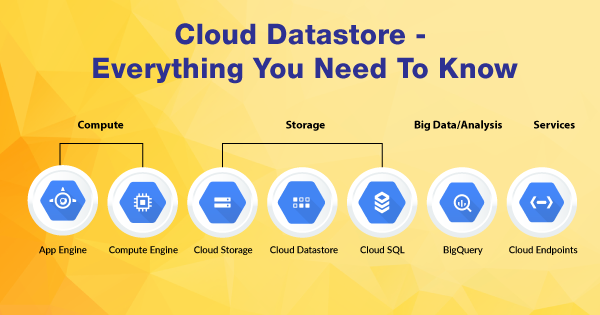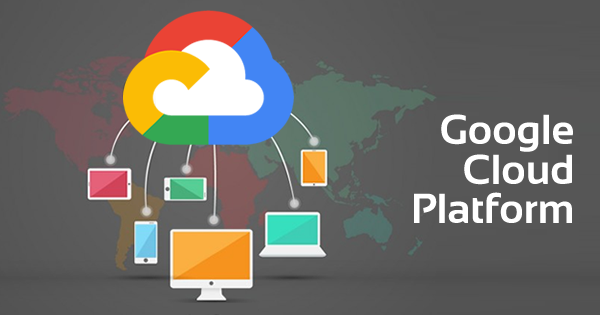Google Cloud Datastore is a NoSQL database with high scalability for the applications. The purpose of Cloud Datastore is to handle replication and sharding aspects, to give you a durable and available database for automatic scaling of the load embedded over applications. Google Cloud Datastore offers high-end capabilities that include SQL-like queries, ACID transactions, indexes, and others, to help enhance the end outcomes. It is not just feasible concerning your scaling aspects but also takes care of application development and high performance.
Cloud Datastore is rich with high-end functionalities to carry out atomic transactions. The datastore has the potential to execute several sets of operations. Under these transactions, you can ensure to get either all of the operations to work seamlessly or all to fail! There is nothing in between! The storage and data querying potential is commendable with Google Cloud Datastore. It maps efficiently to Object-Oriented Languages and Scripting languages, with natural measures. And it is then exposed to the applications through diverse clients.
Planning to take Google Cloud Certifications? Check out Whizlabs online courses and practice tests here!
There is an endless possibility and various features within Cloud Datastore that makes it an impactful service by Google Cloud. Therefore, to help you know more, this article will enlighten you with everything that you need to know about Cloud Datastore.
Working Overview of Cloud Datastore
Cloud Datastore is meant for applications that demand reliability upon the highly available structured data at a fixed scale. You can make use of the Google Cloud Datastore to store & query different types of data that include product catalogs, user profiles, and transactions. The product catalogs that intend to offer real-time inventory and other associated product details for the retailer can be stored and queried within Cloud Datastore.
The user profile data is often intended to deliver customized experiences based upon past preferences and activities. This data is then stored and queried with Cloud Datastore for the required database. Datastore is not suitable for all of the use cases, such as analytic data. Datastore doesn’t have the properties of a relational database, which makes it inefficient for the analytics data!
Read a simplified Introduction to Google Cloud Platform!
At high-end levels, Cloud Datastore is best suitable for storing the transactions and hierarchical data. All of this stored data consists of a flexible and non-relational schema. There is a specific range of requirements for you to use Datastore over your web application. Therefore, if the web application requirement matches any of the below cases, then you can go ahead with the adaptation of Cloud Datastore:
- If you are in need of any amount of less or more storage capacity, Datastore can help you with it! Datastore has the potential to handle data storage from Kilobytes to Petabytes. And there will be no fluctuation in the performance for it!
- ACID (Atomicity, Consistency, Isolation, and Durability) compliant and multi-document transactions are supported with Cloud Datastore.
- Cloud Datastore has the potential to help support the primary, secondary & composite indexes. If you are willing to know more about indexes, you can refer to this specific Google documentation upon Indexes, for the same!
- Datastore by Google Cloud encrypts all of the data automatically before it can be written over the disk. And it is also offering Identity & Access Management (IAM). It is important for implementation upon the web applications to permit accessibility to individuals for accessing specific resources or to prevent someone from accessing select resources. To get a better idea of Identity and Access Management protocol within Google Cloud and Datastore, refer to this official documentation for IAM.
Google Cloud Datastore offers two redundancy levels that depend upon the replications within multiple locations. The levels include Regional replication and multi-region replication:
Under regional replication, the data undergoes replication within at least 3 varying zones but within that same region. Hence, this will make that database more resilient towards zonal outages. Regional replication is preferable for implementing low write latency. Under it, you can prefer co-locating the computing machines of the application within that same region.
The multi-region replication allows replication of data, within multiple zones, across a minimum of two regions. Hence, this brings out the result of enhanced availability and redundancy. But in the resulting outcome, the write latency gets higher. A witness node is proposed and deployed within the third region to be the tiebreaker between every two regions.
Read more on Everything about App Engine!
Hence, the abilities of Google Cloud Datastore databases are efficient and are productive for the users to pick. Datastore has the ability to meet diverse requirements for web applications, which makes it an ideal choice for several use cases that include:
1. User Profiles
Cloud Datastore can be used for customizing select user experiences by keeping track of their past preferences and activities. The flexible schema of Datastore allows you to evolve the user profile structures.
2. Real-Time Inventories
Cloud Datastore offers nested entities for storage of sparse and non-homogenous data for different products. There is no need for carrying out overspecialization of the structure for completing this aspect. Datastore will make it feasible for you!
3. State Mutations
It is used for state mutations within the gaming sector that helps with maintaining a consistent state for all of the players. You can make use of the ACID transactions for propagating the mutations amidst the concurrent users.
4. User Session Management
This is the use case implemented onto the shopping carts in retail or multipart processing form. This use case is especially for booking events. And the ACID transaction possibility with Datastore allows the users to lock down some of the items for a specific time until the transaction completes.
Firestore within the Google Cloud Datastore Mode
Google Firestore is the latest version of Google Cloud Datastore that has embedded quite some improvements that have made it a better version in comparison to its predecessor. The users who have access to the older version of Google Cloud Datastore can access all of these improvements with little tweaks. The users will have to create a Firestore within the Datastore mode instance. Later in the future, Google Cloud has plans to migrate all of the databases under Cloud Datastore, automatically to Google Firestore, in the Datastore mode.
The Firestore within the Datastore mode makes use of the existing Google Cloud Datastore system but accesses a different storage layer. And this accessibility into the modern Firestore storage layer eradicates the limitations that were imposed by Google Datastore. Some of the limitations that were handled with the introduction of Firestore in Cloud Datastore mode are:
- The Cloud Datastore queries have the limitation to be strongly consistent until you put up a request for eventual consistency. Firestore intends to suppress this limitation!
- The queries that are within the Cloud Datastore do not need to be the ancestor queries after the introduction of Firestore within Datastore.
- The number of transactions within Google Cloud Datastore doesn’t have a limit of 25 entity groups anymore after the Firestore upgrade.
- Writes to any of the entity groups, has no more 1/second limits, after Firestore integration with Cloud Datastore.
Pricing for the Google Cloud Datastore Service
The pricing is based upon the usage of Firestore in Datastore, as of present utilization. Firestore within Datastore mode gives you the privilege to start the usage without any cost. There is a limit set upon the free usage that you can enable within your billing account for access.
The usage pattern is recorded daily, and it resets at a specific midnight Pacific time. The limits of free usage are as follows:
- Entity Reads- You get 50,000 entity reads per day.
- Entity Writes- You get 20,000 entity writes per day.
- Entity Deletes- You get 20,000 entity deletes per day.
- Stored Data- You get 1 GB of free usage.
- Network Egress- You get a free network egress of 10 GiB every month.
- Small Operations- You are allowed to carry out 50,000 free small operations every day.
When you cross the free usage limits, then you have to pay a minimal price for using the services. The price chart, along with the rates, beyond free usage limits, include:
- Document Reads- You will be paying $0.06 for every 100,000 document reads after the free usage.
- Document Writes- You will be paying $0.18 for every 100,000 documents writes after the free usage.
- Document Deletes- You will be paying $0.02 for every 100,000 document deletes after the free usage.
- Stored Data- You will be paying $0.18 per GiB per month after the free usage limit.
- Small Operations- There are no such charges specified by Google for small operations even beyond the free usage.
There are some variations in terms of pricing, depending upon the regional differences. Therefore, it is important for you to understand all pricing variations thoroughly. And for that, you need to refer to this official documentation for the pricing of Firestore within Cloud Datastore.
Small operations within Firestore in Cloud Datastore are referred to as calling of allocated IDs, keys-only queries, projection queries, and others. Small operations are free even beyond free usage, but you need to enable billing within your account to keep a record of exceeding the free usage limits every day.
Apart from the services, you are also being charged for the network bandwidth that is used by the Firestore in Datastore mode. The cost of the network bandwidth request is directed upon the response size of the request, location of the database, and destination of that response.
Must read: What is Cloud SQL!
Under the general network pricing chart, you do not have to pay anything for Ingress, Egress within region, Egress between the regions, within one multi-region, and egress between the regions of US. These network offerings are free, but you will have to pay for egress between the regions, the traffic of which is not included within the US regions. You will have to pay $0.01 per GiB after you have used the 10GiB free tier usage every month.
To know more, you can refer to the rates for Google Cloud Platform internet egress. So, make sure you get a complete idea of the egress rates by visiting this section of the official pricing documentation.
Comparison Between the Datastore, Firestore, and Relational Database
Google Cloud Datastore does possess an interface that has substantially similar features as that of the traditional databases. But, as Cloud Datastore is a NoSQL database, it differs from traditional databases in a noticeable manner. The comparison results are highlighted in the image below for better enlightenment:
| Concept | Datastore | Firestore | Relational database |
| Category of object | Kind | Collection group | Table |
| One object | Entity | Document | Row |
| Individual data for an object | Property | Field | Column |
| Unique ID for an object | Key | Document ID | Primary Key |
The relational database table consists of rows in it, whereas the entities of Datastore possess different properties. But if the entities vary, then the properties might be of the same name, but the value might vary! It is somehow a unique characteristic that implies a different way in terms of managing and designing data for taking advantage of implementing auto-scaling ability.
Read more about What is BigQuery!
To be more precise, here are the ways with which you can consider Datastore to be different from that of the traditional or relational database:
- Cloud Datastore has the potential to implement auto-scaling for the larger data sets. Hence, it allows the applications to emit high performance whenever they receive high traffic.
- Cloud Datastore intends to write scale by distributing the data automatically, whenever necessary.
- Cloud Datastore doesn’t intend to offer support for inequality filtering, multiple properties, or to join operations. Apart from that, Cloud Datastore is not even offering filtering aspects based upon data over the subquery results.
- Cloud Datastore is completely schemaless, which is not the case with a traditional relational database. There is no necessity for entities that resembles the same kind to have consistent property sets.
Bottom Line
Cloud Datastore is the schemaless database that has the potential of storing non-relational data. The ease of preference for Cloud Datastore databases is the same as that of relational databases. But, there are some potential key differences between them that are highlighted above in this article!
But, in case you are looking for a relational database with support of full SQL, then it is better to go with Cloud SQL over Cloud Datastore for better proficiency. Apart from that, the support for ACID transactions is what makes Datastore a success. Get your hands-on experience with Cloud Datastore, and test out the features and efficacy that you have learned so far.
- Cloud DNS – A Complete Guide - December 15, 2021
- Google Compute Engine: Features and Advantages - December 14, 2021
- What is Cloud Run? - December 13, 2021
- What is Cloud Load Balancing? A Complete Guide - December 9, 2021
- What is a BigTable? - December 8, 2021
- Docker Image creation – Everything You Should Know! - November 25, 2021
- What is BigQuery? - November 19, 2021
- Docker Architecture in Detail - October 6, 2021



